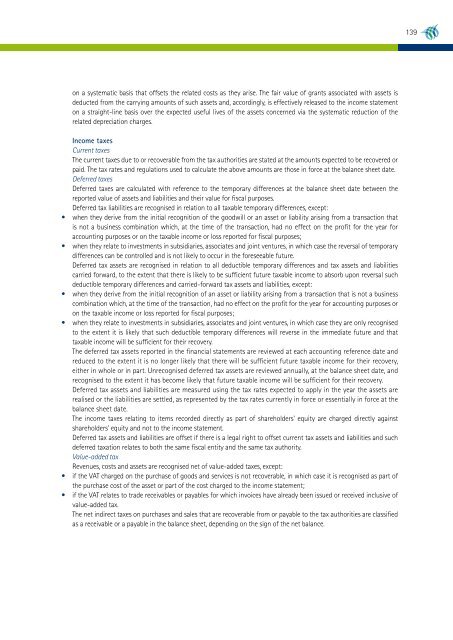Save PDF - Manutencoop
Save PDF - Manutencoop
Save PDF - Manutencoop
Create successful ePaper yourself
Turn your PDF publications into a flip-book with our unique Google optimized e-Paper software.
139<br />
on a systematic basis that offsets the related costs as they arise. The fair value of grants associated with assets is<br />
deducted from the carrying amounts of such assets and, accordingly, is effectively released to the income statement<br />
on a straight-line basis over the expected useful lives of the assets concerned via the systematic reduction of the<br />
related depreciation charges.<br />
Income taxes<br />
Current taxes<br />
The current taxes due to or recoverable from the tax authorities are stated at the amounts expected to be recovered or<br />
paid. The tax rates and regulations used to calculate the above amounts are those in force at the balance sheet date.<br />
Deferred taxes<br />
Deferred taxes are calculated with reference to the temporary differences at the balance sheet date between the<br />
reported value of assets and liabilities and their value for fiscal purposes.<br />
Deferred tax liabilities are recognised in relation to all taxable temporary differences, except:<br />
• when they derive from the initial recognition of the goodwill or an asset or liability arising from a transaction that<br />
is not a business combination which, at the time of the transaction, had no effect on the profit for the year for<br />
accounting purposes or on the taxable income or loss reported for fiscal purposes;<br />
• when they relate to investments in subsidiaries, associates and joint ventures, in which case the reversal of temporary<br />
differences can be controlled and is not likely to occur in the foreseeable future.<br />
Deferred tax assets are recognised in relation to all deductible temporary differences and tax assets and liabilities<br />
carried forward, to the extent that there is likely to be sufficient future taxable income to absorb upon reversal such<br />
deductible temporary differences and carried-forward tax assets and liabilities, except:<br />
• when they derive from the initial recognition of an asset or liability arising from a transaction that is not a business<br />
combination which, at the time of the transaction, had no effect on the profit for the year for accounting purposes or<br />
on the taxable income or loss reported for fiscal purposes;<br />
• when they relate to investments in subsidiaries, associates and joint ventures, in which case they are only recognised<br />
to the extent it is likely that such deductible temporary differences will reverse in the immediate future and that<br />
taxable income will be sufficient for their recovery.<br />
The deferred tax assets reported in the financial statements are reviewed at each accounting reference date and<br />
reduced to the extent it is no longer likely that there will be sufficient future taxable income for their recovery,<br />
either in whole or in part. Unrecognised deferred tax assets are reviewed annually, at the balance sheet date, and<br />
recognised to the extent it has become likely that future taxable income will be sufficient for their recovery.<br />
Deferred tax assets and liabilities are measured using the tax rates expected to apply in the year the assets are<br />
realised or the liabilities are settled, as represented by the tax rates currently in force or essentially in force at the<br />
balance sheet date.<br />
The income taxes relating to items recorded directly as part of shareholders' equity are charged directly against<br />
shareholders' equity and not to the income statement.<br />
Deferred tax assets and liabilities are offset if there is a legal right to offset current tax assets and liabilities and such<br />
deferred taxation relates to both the same fiscal entity and the same tax authority.<br />
Value-added tax<br />
Revenues, costs and assets are recognised net of value-added taxes, except:<br />
• if the VAT charged on the purchase of goods and services is not recoverable, in which case it is recognised as part of<br />
the purchase cost of the asset or part of the cost charged to the income statement;<br />
• if the VAT relates to trade receivables or payables for which invoices have already been issued or received inclusive of<br />
value-added tax.<br />
The net indirect taxes on purchases and sales that are recoverable from or payable to the tax authorities are classified<br />
as a receivable or a payable in the balance sheet, depending on the sign of the net balance.








